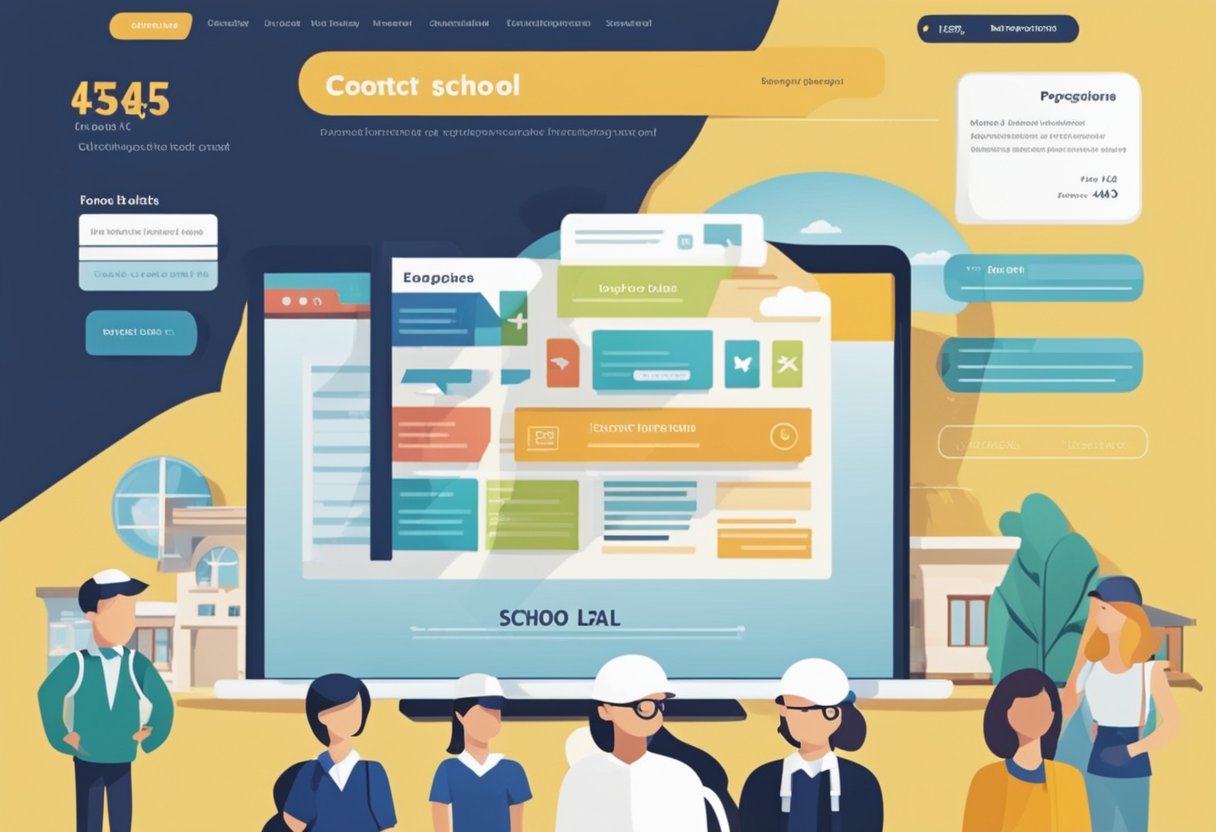Efficient and visually appealing school websites serve as a window into the educational experience an institution provides. They are critical tools for communication, serving the needs of current students, staff, parents, and the wider community, while also engaging prospective families and educators. The digital presence of a school can significantly impact a viewer’s first impression, often influencing their decision to pursue further interaction or consideration.

Designing the best school website involves a careful blend of aesthetics, functionality, and accessibility. It should cater to the diverse requirements of its visitors, providing easy access to essential information while highlighting the school’s achievements and culture. Effective websites balance these elements to create a user-friendly, informative, and inviting online experience for all visitors, aligning with the school’s mission and ethos.
Key Takeaways
- A school’s website is crucial for engagement and communication with various stakeholders.
- The best school websites provide a harmonious mix of design, functionality, and ease of access.
- They effectively represent the school’s values and achievements while ensuring a positive user experience.
Defining the Ideal School Website

When you’re considering how to conceptualize and reflect your school’s mission effectively online, the key lies in designing a school website that serves as more than just a digital brochure. Your website should encapsulate your institution’s ethos, guiding principles, and educational purpose to inform and engage the community.
Core Features
- Information Accessibility: Quick access to essential information like admissions, faculty contacts, and academic calendars.
- Branding Consistency: It’s crucial that your website’s color scheme and theme align with your school’s established branding, promoting instant recognition.
Unique Elements
- Unique Design: Aim for a layout that stands out, yet remains functional and user-friendly, encouraging visitors to explore and learn more about your school.
- Updated Content: Ensure consistent updates with current events, news, and achievements to maintain relevancy.
Strategic Goals
- Engagement Goals: The website should host interactive features that facilitate communication between students, parents, and teachers.
- Educational Objectives: Highlight your educational aims through content that reflects your institution’s academic standing and accomplishments.
Incorporating these elements into the development of your school website will position it among the best school websites not solely for 2023 but as a lasting digital representation of your institution.
Key Features of Effective School Websites

When you’re assessing school websites, certain features stand out that not only draw your attention but also ensure a pleasant user experience. These aspects include the richness and regular updates of content, the visual accessibility and appeal of the site, and the level of engagement and interactivity offered to visitors.
Content Richness and Updates
Timely Updates: Regular updates on school events, latest news, and educational blog posts should be a cornerstone of any school website, keeping its community informed and engaged. A ‘Trending Now’ section can offer quick access to the most current happenings.
Informative Content: Your website should serve as a repository for comprehensive and regularly refreshed content, from curricular details to upcoming events. It’s not just about having content, but ensuring it’s relevant and valuable to your audience.
Visual Appeal and Accessibility
Responsive Design: School websites must boast a responsive design, meaning it adapts seamlessly to any device, ensuring all users have full access to the website’s functions.
Inclusive Imagery and Icons: Icons and imagery used across the website should reflect the school’s diverse community and mission while being eye-catching. Infographics can also condense complex information into digestible visuals which enhance understanding and retention.
Engagement and Interactivity
Interactive Elements: From interactive polls to animated calls to action (CTAs), dynamic elements can make the experience more engaging. These tools should facilitate rather than complicate the user experience, guiding users with clear navigation.
Accessibility Options: To maintain inclusivity, features such as alternative text for images and the ability to adjust font size or contrast are essential. They ensure that all users, regardless of ability, can interact fully with your site.
Structuring for Various Audiences

When structuring your school’s website, it’s imperative to address the needs of all audience groups, including parents, students, and educators, ensuring that each section is easily navigable and tailored to provide relevant information quickly and clearly.
Parent and Family Centered
For parents and families, create a section that serves as a central hub, offering easy access to essential information. Here, you should incorporate elements such as recent announcements, upcoming events, and academic calendars. Include testimonials from other parents to build trust and reviews of the educational programs. This can foster a sense of community and keep families engaged with school happenings.
Student Focused Sections
Students need a dedicated area that speaks directly to their interests and academic needs. Ensure the section includes academic resources, extracurricular information, and student-centered news. Highlight successes through student testimonials and integrate social proof to encourage prospective students’ faith in the institution. It’s important that this section is both informative and inspiring.
Educator and Staff Resources
For educators and staff, having a dedicated section for professional development resources, teaching materials, and faculty achievements is crucial. This portal should be designed to streamline their workflow, with easy access to administrative tools and education platforms. By highlighting faculty reviews and community accolades, you ensure that educators are recognized for their contributions, which in turn strengthens community support.
Showcasing School Achievements and Culture

When you visit a school website, you expect to see a proud display of what the school stands for—its achievements, the vibrancy of student life, and its community involvement. Here’s how effective websites showcase these facets.
Academic Excellence
Schools often highlight their academic excellence through a dedicated achievements section, which might include tables of standardized test scores, graduation rates, and college acceptance statistics. For instance, they may feature a gallery of award ceremonies or scholarship recipients. A curriculum page typically details advanced placement offerings or special academic programs, often accompanied by a virtual tour of state-of-the-art facilities.
Extracurricular Activities
Extracurricular activities form the heartbeat of a school’s culture. A dynamic website would typically list clubs, sports, and arts programs, with photos or video links in the activities section. Here, you may find highlighted events, like a chess team’s tournament victories or the drama club’s latest production, illustrating the school’s showcase of talent and variety of interests.
- Sports Achievements: Game scores, league standings, and athlete highlights.
- Arts and Clubs: Recent performances, exhibitions, and special project features.
Community Involvement
A school is not an island; its website reflects its community integration. This could be represented by a timetable of community service events, partnerships with local businesses, or outreach programs. Schools with a strong school spirit often include a blog or news feed that chronicles these activities, emphasizing the school’s role in the broader community and the value of civic engagement.
- Service Projects: Overviews and galleries of recent initiatives, emphasizing student leadership.
- Partnerships: Descriptions and impacts of collaborations with local organizations.
Optimizing for Search Engines and User Experience
https://www.youtube.com/watch?v=DvwS7cV9GmQ&embed=true
To excel in the digital space, your school’s website must cater to both search engine algorithms and provide an excellent user experience. Balancing these aspects can dramatically enhance your online visibility and engage visitors effectively.
SEO Best Practices
Content Quality:
- Create unique, informative content that serves your audience’s needs, leveraging a content management system (CMS) like WordPress, Wix, Squarespace, or Weebly for ease of updates.
Keyword Optimization:
- Conduct thorough keyword research relevant to the educational space to guide your SEO strategy. This will inform everything from on-page content to meta descriptions.
Technical SEO:
- Ensure your site has a clean, logical URL structure and employs proper use of meta tags. Both can significantly impact how search engines understand and rank your pages.
Mobile Optimization:
- With the majority of internet browsing now on mobile devices, a responsive design is crucial for both SEO value and user experience.
Analytics:
- Utilize tools to monitor SEO performance, such as Google Analytics or dedicated plugins if you’re using WordPress or similar platforms.
User Experience Essentials
Page Experience:
- Site speed is paramount: Fast loading times are non-negotiable for user satisfaction and can affect rankings. You should improve your school website’s page experience and core web vitals.
Navigation:
- Make sure your menu and page layout are intuitive. Users should find what they’re looking for without confusion or frustration.
Accessibility:
- Your website should be accessible to all users, including those with disabilities. This includes using alt text for images and ensuring high contrast ratios for text.
Engagement:
- Engage visitors with interactive elements such as videos, virtual tours, and clear call-to-action (CTA) buttons to boost time spent on your site, which can improve your SEO performance as well.
Frequently Asked Questions
https://www.youtube.com/watch?v=s_c5co184y8&embed=true
In this section, you’ll find targeted answers on what makes a school website genuinely effective and engaging, from essential features to design impact and best practices for upkeep.
What features should a high-performing school website include?
A high-performing school website should offer easy navigation, updated content, responsive design compatible with various devices, and accessible contact information. Integration of academic resources, event calendars, and enrollment information is also critical.
How can website design influence a student’s choice of school?
An appealing and intuitive website design can significantly influence a potential student’s perception of a school. It’s often the first interaction they have, and a positive experience can sway their decision towards applying and attending.
What are the essentials of a user-friendly school website for students and parents?
User-friendly school websites prioritize clear communication channels, straightforward access to learning materials, and detailed guides on school systems. They ensure that information such as term dates, school policies, and support services is easy to find and understand for both students and parents.
What criteria should be used to evaluate the effectiveness of a school district’s website?
Effectiveness can be measured by website accessibility, the accuracy of provided information, the relevance of the content related to educational programs and policies, and the presence of features that facilitate school-community interaction.
How do the best primary school websites enhance parent and community engagement?
The best primary school websites serve as a hub for community involvement by offering regular updates on school events, volunteer opportunities, and platforms for feedback, fostering a strong connection between the school, the parents, and the broader community.
What are some best practices for maintaining and updating a school website?
Ongoing maintenance of a school website should include regular content reviews to ensure information is current, implementing security updates, and gathering user feedback for continuous improvement. It’s also beneficial to periodically revisit website functionality and compatibility across devices.
